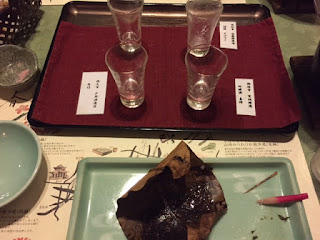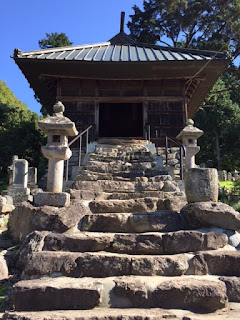<お正月 Oshōgatsu New Year’s Day>
日本人がどうやってお正月を祝うのか知っていますか。
お正月は日本人にとって、とても大切な祝日です。沢山の特別の行事が行われます。
Do you know how Japanese people celebrate
their New Year’s Day?
New Year’s Day is the most important
holiday in Japan. Many special events
take place during the first three days.
① 初詣---沢山の人が神社やお寺に行って一年の幸運を祈ります。
Hatsumōde---Many people go to the shrine and temples wishing for the good
Fortune and
good luck during the year ahead.
② おせち料理---お正月におせち料理という特別な料理を食べます。おせち料理は
 重箱と言われるうるしの箱にきれいに並べられています。
重箱と言われるうるしの箱にきれいに並べられています。
People eat special food
called Osechi ryōri (New Year’s special food)
Osechi ryōri are beautifully arranged in the lacquer box called Jubako.
それぞれの料理には特別の意味があります。
Each dish has some
special meanings.
黒豆--まめに働きまめ(健康)になります。
Kuromame (black beans)
—working hard
and become healthy.
 伊達巻---学問が上達します。
伊達巻---学問が上達します。
Datemaki( egg omelet)
Because the shape looks like a scroll, it is
associated
with scholarship.
 きんとん---お金持ちになります。
きんとん---お金持ちになります。
Kinton (sweet potatoes and
chestnuts)
the word ‘kinton’ means
golden dumplings, and the color looks like a gold.
It is associated with treasure.
 こぶまき---幸せになります
こぶまき---幸せになります
Kobumaki (dried herring wrapped in
seaweed)
the word ‘kobu’ means to be happy.
 田作り---収穫にめぐまれます。
田作り---収穫にめぐまれます。
Tazukuri (dried sardines)
In ancient times, dried sardines were used for fertilizer for the
rice field.
Also Tazukuri literally translates as ‘making rice corps’. It is
associated with
Good harvest.
 数の子--- 子宝に恵まれます。
数の子--- 子宝に恵まれます。
Kazunoko (herring roe)
Herring roe contains a lot of eggs and the word ‘kazu’ means number
and ‘ko’ means children. That means you are blessed with many children.
 海老---- 長く生きられます
海老---- 長く生きられます
Ebi(shrimp)
Because the
shape of curved body, it is associated with longevity. Because when
people get
older, their bodies are hunchbacked.
③お雑煮を食べます。
お雑煮は、お正月に食べられる特別な汁物です。地域によって具材やだしが違います。
Ozōni is a special soup eaten on New Year’s Day. Ingredients for Ozōni differ from region to region.

関東Kanto style (clear soup)
 関西 Kansai(white
miso soup)
関西 Kansai(white
miso soup)
④年賀状をもらいます。
2015年の干支は羊です。羊の絵がついた年賀状を交換します。
We receive New Year’s Cards on New Year’s
Day. The Chinese zodiac sign of the 2015
will be the year of the sheep ‘hitsuji’. So you will exchange many
nengajo like Christmas cards with the picture of the sheep.
⑤お正月の飾り
門松と鏡餅を飾っておき、氏神様をお迎えします。
We have placed ‘kadomatsu’ in pairs in
front of houses to welcome year God and
displayed ‘Kagamimochi’ for the offering to Year God.
鏡餅 形が鏡に似ています。
kagamimochi/mirror rice cake
The
round shape looks like a mirror.
門松
Kadomatsu/pine decorations
皆様昨年一年大変お世話になりました。
Thank you for everything you
did for us this past year.
どうぞ良いお年をお迎え下さい。
Please
have a good new year!
---- by Yada-sensei
































